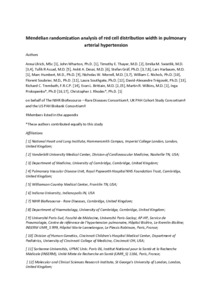Ulrich, A;
Wharton, J;
Thayer, TE;
Swietlik, EM;
Assad, TR;
Desai, AA;
Gräf, S;
Harbaum, L;
Humbert, M;
Morrell, NW;
et al.
Ulrich, A; Wharton, J; Thayer, TE; Swietlik, EM; Assad, TR; Desai, AA; Gräf, S; Harbaum, L; Humbert, M; Morrell, NW; Nichols, WC; Soubrier, F; Southgate, L; Trégouët, D-A; Trembath, RC; Brittain, EL; Wilkins, MR; Prokopenko, I; Rhodes, CJ; NIHR BioResource – Rare Diseases Consortium; UK PAH Cohort Study Consortium; US PAH Biobank Consortium
(2020)
Mendelian randomisation analysis of red cell distribution width in pulmonary arterial hypertension.
Eur Respir J, 55 (2).
p. 1901486.
ISSN 1399-3003
https://doi.org/10.1183/13993003.01486-2019
SGUL Authors: Southgate, Laura
![[img]](https://openaccess.sgul.ac.uk/111437/1.hassmallThumbnailVersion/Ulrich%20et%20al%202019_ERJ%20accepted.pdf)  Preview |
|
PDF
Accepted Version
Available under License ["licenses_description_publisher" not defined].
Download (1MB)
| Preview
|
Abstract
Pulmonary arterial hypertension (PAH) is a rare disease that leads to premature death from right heart failure. It is strongly associated with elevated red cell distribution width (RDW), a correlate of several iron status biomarkers. High RDW values can signal early stage iron deficiency or iron deficiency anaemia. This study investigated if elevated RDW is causally associated with PAH.A two-sample Mendelian randomisation (MR) approach was applied to investigate whether genetic predisposition to higher levels of RDW increases the odds of developing PAH. Primary and secondary MR analyses were performed using all available genome-wide significant RDW variants (n=179) and five genome-wide significant RDW variants that act via systemic iron status, respectively.We confirmed the observed association between RDW and PAH (OR=1.90, 95% CI=1.80-2.01) in a multi-centre case-control study (N cases=642, N disease controls=15 889). The primary MR analysis was adequately powered to detect a causal effect (OR) from between 1.25 and 1.52 or greater based on estimates reported in the RDW GWAS or from our own data. There was no evidence for a causal association between RDW and PAH in either the primary (ORcausal=1.07, 95% CI=0.92-1.24) or the secondary (ORcausal=1.09, 95% CI=0.77-1.54) MR analysis.The results suggest that at least some of the observed association of RDW with PAH is secondary to disease progression. Results of iron therapeutic trials in PAH should be interpreted with caution as any improvements observed may not be mechanistically linked to the development of PAH.
| Item Type: |
Article
|
| Additional Information: |
This is an author-submitted, peer-reviewed version of a manuscript that has been accepted for publication in the European Respiratory Journal, prior to copy-editing, formatting and typesetting. This version of the manuscript may not be duplicated or reproduced without prior permission from the copyright owner, the European Respiratory Society. The publisher is not responsible or liable for any errors or omissions in this version of the manuscript or in any version derived from it by any other parties. The final, copy-edited, published article, which is the version of record, is available without a subscription 18 months after the date of issue publication. |
| Keywords: |
NIHR BioResource – Rare Diseases Consortium, UK PAH Cohort Study Consortium, US PAH Biobank Consortium, 11 Medical And Health Sciences, Respiratory System |
| Journal or Publication Title: |
Eur Respir J |
| ISSN: |
1399-3003 |
| Language: |
eng |
| Publisher License: |
Publisher's own licence |
| Projects: |
|
| PubMed ID: |
31744833 |
| Dates: |
| Date |
Event |
| 2020-02-01 |
Published |
| 2019-11-19 |
Published Online |
| 2019-10-29 |
Accepted |
|
 |
Go to PubMed abstract |
| URI: |
https://openaccess.sgul.ac.uk/id/eprint/111437 |
| Publisher's version: |
https://doi.org/10.1183/13993003.01486-2019 |
Statistics
Item downloaded times since 28 Nov 2019.
Actions (login required)
 |
Edit Item |



